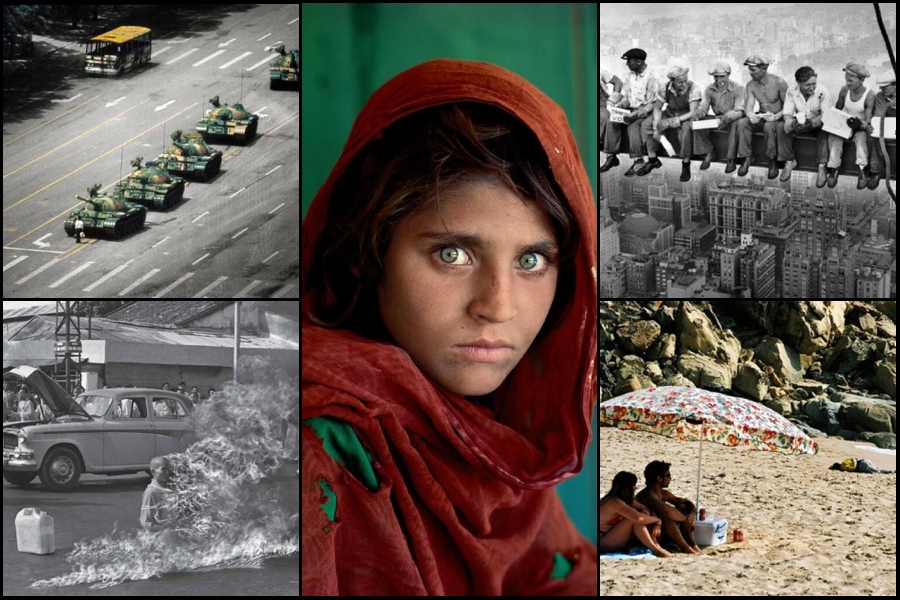
Published :
Updated :

Photographs are not just still moments; they are powerful tools that can capture and alter history in its purest form. They can inspire people, ignite revolutions, and shape public opinion in ways that words alone cannot. Certain photographs have transcended their frames to become pivotal turning points, forever altering the course of history. Each click of a camera shutter has the potential to capture a moment that can change the world.
Photography profoundly impacts international relations, serving as a powerful tool for shaping public opinion, influencing diplomatic discourse, and mobilising global responses to critical issues. Iconic images documenting war atrocities, humanitarian crises, and acts of resistance can galvanise public outcry, prompting governments to take action or alter foreign policies.
Conversely, propaganda photography can be used to manipulate perceptions, justify military interventions, or vilify adversaries, thus shaping the narrative surrounding international conflicts. Photojournalism holds governments and international organisations accountable by providing visual evidence of human rights abuses, political oppression, and environmental degradation. In diplomatic circles, photographs can serve as potent symbols, capturing historic moments of diplomacy or discord and influencing public perceptions of foreign leaders and nations.
Social media and digital platforms have further democratised the dissemination of images, allowing citizens worldwide to engage directly with global events and contribute to discussions on international affairs. Overall, photography's ability to evoke empathy, spark dialogue, and mobilise collective action makes it a formidable force in shaping the dynamics of international relations.
The first permanent photo (meaning the image would not fade), 'View from the Window at Le Gras' (1826/1827) by Joseph Nicéphore and Louis Daguerre's 'Boulevard du Temple, Paris' (1838) are two photographs that made significant contributions to the field of photography. While the former laid the groundwork for photography, the latter was the first publicly accessible photograph that captured a bustling Parisian street scene and demonstrated the new technology's potential to document reality, a powerful tool for changing historical records.
Photography has completely transformed the way we express and communicate untold stories. One photograph that stands out is 'Lunch atop a Skyscraper' by Charles C. Ebbets (1932). This photo is not just about construction workers having lunch on a girder high above New York City; it has become an enduring symbol of American resilience and optimism during the Great Depression. The calm posture of the men on the girder, despite the dizzying heights, speaks volumes about their unwavering spirit in the face of hardship.
Dorothea Lange's 'Migrant Mother' (1936) is undeniably one of the most significant and influential photographs ever taken. The image of a distressed mother and her children has become a defining symbol of the Great Depression and the struggles of migrant workers during that period. Its powerful message continues to resonate with people worldwide, inspiring and motivating them to take action against social and economic injustices, which galvanised public support for government assistance programs.
The image 'Earthrise,' captured by astronaut William Anders during the Apollo 8 mission in 1968, is a breathtaking view of our planet rising above the moon's horizon. This picture profoundly impacted and helped spark a global movement to protect our planet. It offered an unprecedented perspective of our fragile planet, emphasising the necessity for collective action to safeguard it.
John Filo's 1970 shot, The Kent State Shootings, showed the moment when National Guard members opened fire on unarmed student demonstrators at Kent State University, leaving four dead and nine injured. It further inflamed the anti-war movement and came to represent the rising tensions and violence surrounding the Vietnam War. Nick Ut, The Napalm Girl (1972): In this image from the Vietnam War, a little girl named Kim Phuc is seen wailing and running in her underwear. She had been burned by napalm. It caused uproar against the use of napalm once it was published in Jet magazine, which ultimately helped to bring the conflict to an end.
Next up is the famous image of a lone guy standing bravely in front of tanks during the Tiananmen Square protests in China, taken by Jeff Widener in 1989. After being made public, this picture inspired many individuals worldwide by symbolising bravery and opposition to authoritarianism. Simultaneously, The Fall of the Berlin Wall (1989) showed the joyful celebration of the end of the Cold War and the reunification of Germany; these striking pictures captured the moment. It represented a dramatic turn in world politics and the victory of democracy over communism.
Photos actively participate in creating history rather than just being passive mirrors of the outside world. Images can spark social change, political action, and scientific advancement because of their capacity to arouse emotions, confront prejudices, and elevate the voices of the voiceless. In a world where images are everything, we must always be aware of our power and responsibility while taking and sharing these photos. Not only can they document history, but they can also actively influence its future.


 For all latest news, follow The Financial Express Google News channel.
For all latest news, follow The Financial Express Google News channel.